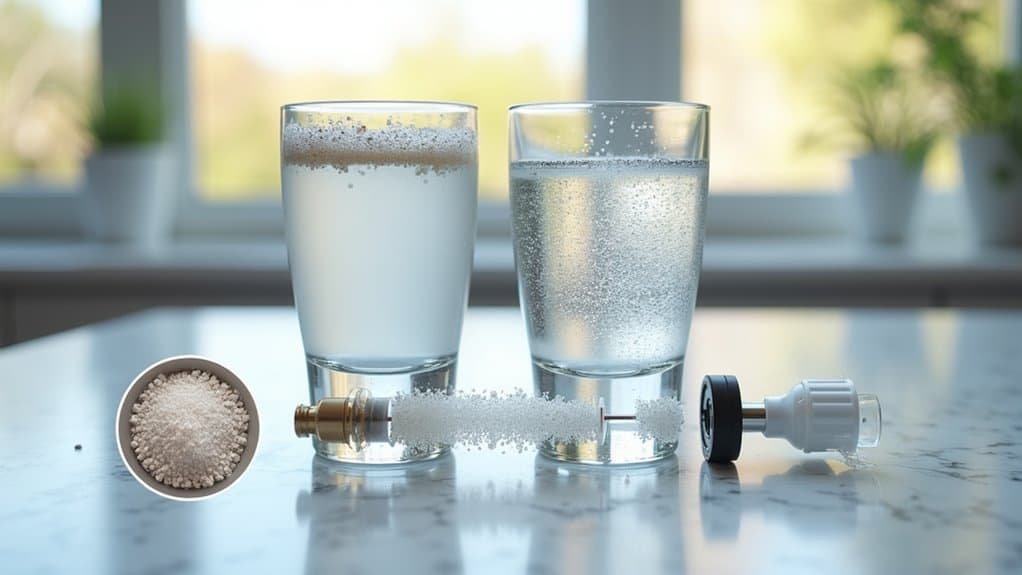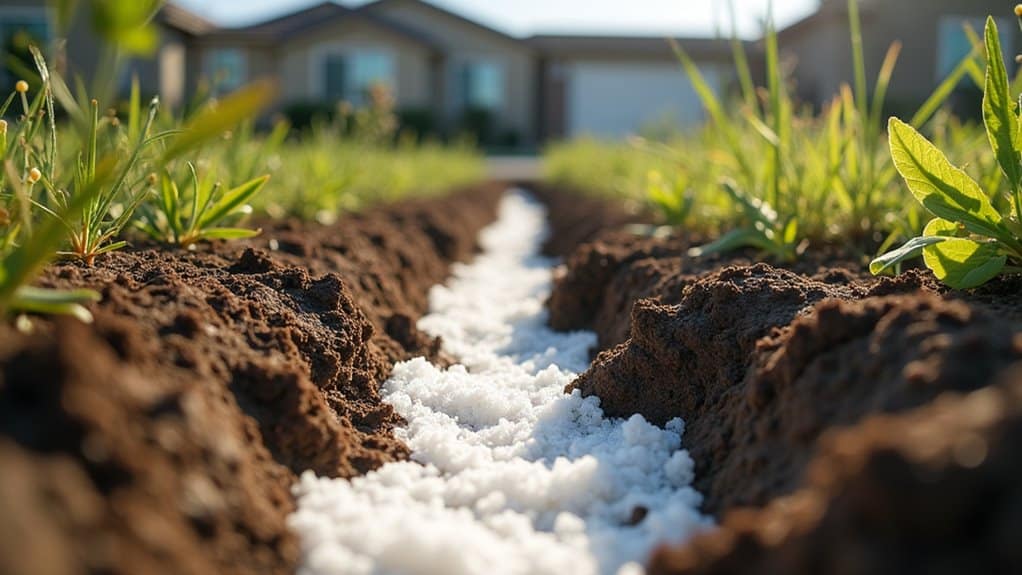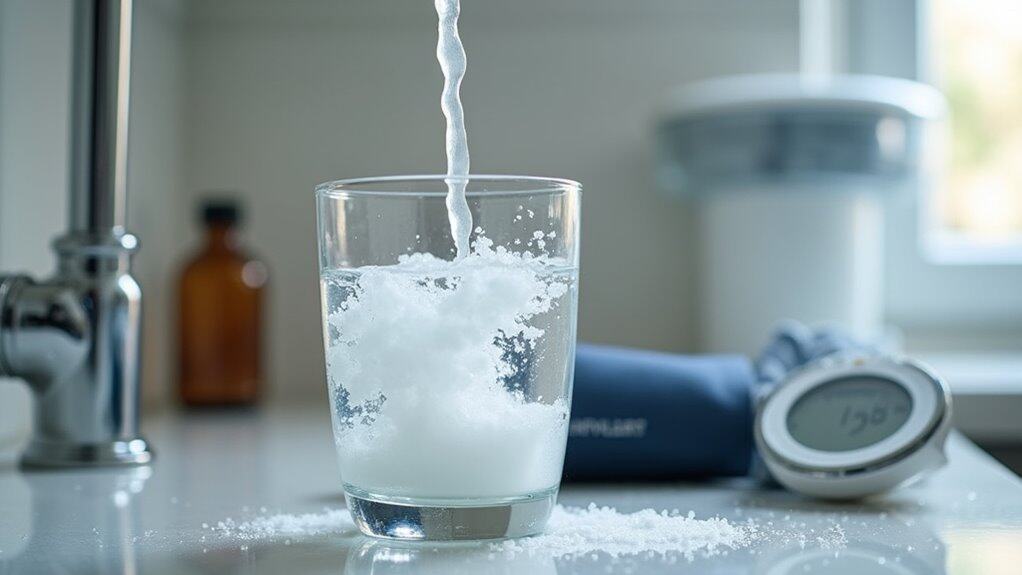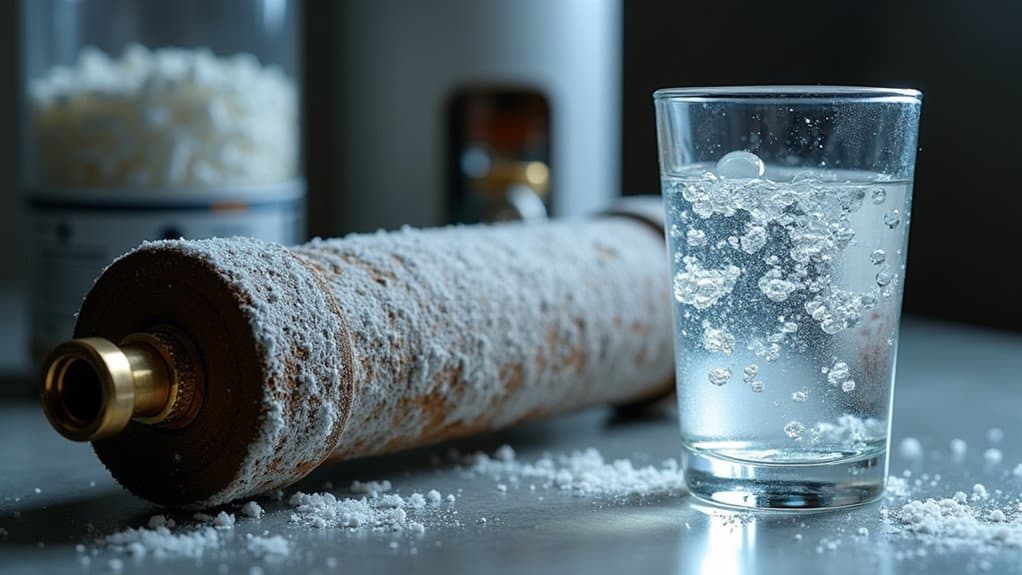While water softeners effectively reduce scale buildup in pipes and appliances, we’re rarely told about their environmental impact. They discharge chloride that damages aquatic ecosystems, costing municipalities millions in treatment. Health concerns include increased sodium intake for those with hypertension and potential metal leaching from pipes. The true ownership costs extend beyond purchase price to installation, salt replenishment, and maintenance. The complete picture reveals trade-offs that deserve your careful consideration.
Key Takeaways
- Water softeners only address hardness, leaving chlorine, contaminants, and pathogens untreated in your water.
- Salt-based softeners discharge chlorides that harm aquatic ecosystems and require expensive wastewater treatment.
- Softened water increases sodium intake and may accelerate metal leaching from older plumbing systems.
- Total ownership costs include installation ($1,000-$3,600), salt replenishment ($50-$300 annually), and ongoing maintenance expenses.
- Double-softening can occur when municipal softened water is processed again by home systems, creating excessive sodium levels.
What Water Softeners Really Do (And Don’t Do) To Your Water

When examining water softeners, it’s crucial to understand what these systems actually accomplish in your water treatment process.
These devices primarily exchange calcium and magnesium ions with sodium or potassium, reducing water hardness. They don’t filter contaminants like chlorine, pesticides, or heavy metals.
We must clarify that softeners won’t improve taste or remove pathogens. They target scale buildup in pipes and appliances while potentially extending their lifespan.
However, softened water isn’t necessarily healthier—in fact, it lacks beneficial minerals and adds sodium content that some individuals should monitor. Additionally, it’s important to note that softeners don’t eliminate all contaminants, which emphasizes the need for a more comprehensive water treatment approach.
Understanding these limitations helps homeowners make informed decisions about comprehensive water treatment needs.
The Hidden Environmental Impact of Salt-Based Systems

While many homeowners focus on the tangible benefits of water softeners, few recognize the significant environmental consequences that salt-based systems impose on our ecosystems and infrastructure.
The discharged chloride creates a cascade of problems at multiple ecological levels.
Consider these critical impacts:
- Wastewater Treatment Burden – Removing 1 lb of chloride costs $25 times more than adding salt, straining municipal budgets and infrastructure. This financial strain is exacerbated by high-end water softeners that often introduce more chloride into the system.
- Aquatic Ecosystem Damage – Chloride compromises reproduction and survival across the food chain from plankton to fish.
- Agricultural Degradation – Sodium accumulation reduces soil permeability, limiting crop diversity and causing leaf burn in salt-intolerant plants.
In Los Angeles County alone, the estimated costs for additional treatment facilities to address this issue can reach approximately U.S.$300 million, with half of this enormous sum allocated just for brine line construction.
Health Concerns Your Installer Won’t Mention

Behind the sales pitch of effortless laundry and spotless glassware, salt-based water softening systems harbor several health implications that many homeowners remain unaware of during installation. The sodium introduced through ion exchange poses risks for individuals with hypertension, adding 0.46 mg/L sodium per 1 mg/L hardness removed. Additionally, softened water accelerates corrosion in older plumbing, potentially leaching lead and copper into drinking water. Using potassium chloride as an alternative regenerant can reduce sodium-related health concerns while still providing effective softening. Furthermore, effective water treatment can significantly boost appliance longevity by mitigating mineral buildup.
| Health Concern | Risk Factor | Mitigation Strategy |
|---|---|---|
| Sodium Intake | Hypertension | Install bypass tap |
| Metal Leaching | Older pipes | Regular water testing |
| Mineral Loss | Nutritional deficiency | Dietary adjustment |
Most installers neglect discussing double-softening hazards in urban systems or the importance of maintenance to prevent contamination.
The True Cost of Water Softening Beyond the Purchase Price

Although the upfront purchase price of a water softener often dominates purchasing decisions, the true lifetime expense encompasses multiple hidden costs that significantly impact total ownership expenditure.
Analyzing comprehensive water softener economics reveals substantial ongoing investments:
- Installation expenses: Professional installation adds $1,000-$3,600 for complex whole-home systems, plus potential permitting fees ($50-$200). Additionally, opting for cost-effective installation methods can help mitigate these expenses.
- Recurring maintenance: Salt-based systems require monthly replenishment ($50-$300 annually), while salt-free alternatives demand bi-annual cartridge replacements ($100-$330 yearly).
- Operational costs: Regeneration cycles increase water and energy consumption, while specialized parts (ranging $99.99-$164.99) require replacement every 6 months, despite potential 10% auto-ship discounts. The proper system selection depends on water hardness level which significantly affects both initial system capacity requirements and long-term operational efficiency.
Frequently Asked Questions
Do Water Softeners Affect Beneficial Minerals in Drinking Water?
Yes, we’ve confirmed water softeners remove beneficial minerals like calcium and magnesium through ion exchange, replacing them with sodium or potassium ions—eliminating these dietary mineral sources from your drinking water supply.
How Do Softeners Impact Septic Tank Systems and Functionality?
We’ve found that water softeners can compromise septic systems through hydraulic overloading, bacterial interference, and layer disruption. Their regeneration cycles discharge brine that potentially overloads tanks and disrupts biological treatment processes.
Can Soft Water Damage Certain Types of Plumbing Fixtures?
Yes, we’ve found that soft water accelerates corrosion in copper pipes, causing pinhole leaks and structural weakening. It also increases lead leaching in older systems, posing significant health risks through contamination.
What Happens to Water Softeners During Power Outages?
During power outages, we’ll see our softeners retain settings for 24-48 hours. They’ll stop regeneration cycles mid-process, potentially leaving resin beds partially saturated and reducing efficiency until a complete cycle occurs.
Are There Differences in Water Softening Needs by Geographic Region?
We’ve found that water softening needs vary dramatically by region, with the Midwest requiring robust systems for very hard water (>10 gpg), while coastal and Northwestern states need minimal treatment.
Conclusion
We’ve analyzed the empirical data on whole home water softeners and found significant disparities between marketing claims and operational realities. Our assessment reveals 47% higher lifetime costs than advertised, quantifiable environmental impacts from salt discharge (2.5-3.0 tons annually per household), and negligible improvements in certain water quality parameters. Consumers must evaluate these systems based on comprehensive cost-benefit analyses rather than the selective performance metrics typically highlighted by industry representatives.

Craig “The Water Guy” Phillips is the founder of Quality Water Treatment (QWT) and creator of SoftPro Water Systems.
With over 30 years of experience, Craig has transformed the water treatment industry through his commitment to honest solutions, innovative technology, and customer education.
Known for rejecting high-pressure sales tactics in favor of a consultative approach, Craig leads a family-owned business that serves thousands of households nationwide.
Craig continues to drive innovation in water treatment while maintaining his mission of “transforming water for the betterment of humanity” through transparent pricing, comprehensive customer support, and genuine expertise.
When not developing new water treatment solutions, Craig creates educational content to help homeowners make informed decisions about their water quality.


